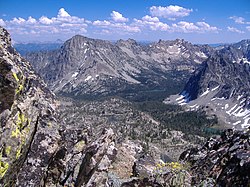Tukudeka

Sawtooth Range, the traditional home of the Tukudeka in central Idaho
|
|
| Total population | |
|---|---|
| (fewer than 5,822) | |
| Regions with significant populations | |
|
|
|
| Languages | |
| Shoshone, English | |
| Religion | |
|
Native American Church, Sun Dance, traditional tribal religion, Christianity, Ghost Dance |
|
| Related ethnic groups | |
| other Shoshone tribes, Bannock, Northern Paiute |
The Tukudeka or Mountain Sheepeaters are a band of Eastern Shoshone, who later joined the Northern Shoshone. They traditionally lived in the central Sawtooth Range of Idaho. Bands were very fluid and nomadic, and they often interacted with and intermarried other bands of Shoshone. Today the Tukudeka are enrolled in the federally recognized tribe, the Shoshone-Bannock Tribes of the Fort Hall Reservation of Idaho.
"Tukudeka" is spelled several ways, including Tukadüka, Tukku Tikka'a, Tukkuikka, Tukkutikka, and Tukuarika, and is translated as "Eaters of White Meat," "Eaters of Mountain Sheep," "Mountain Sheepeaters," or simply, "Sheepeaters." They were named for the bighorn mountain sheep (Ovis canadensis), which they commonly hunted. They are also called Mountain Shoshone or Toyahini, the mountaineers.
The Tukudeka speak the Shoshone language, as well as English. Shoshone is a Central Numic language in the Northern Uto-Aztecan language family.
The Tukudeka's traditional homelands were along the Salmon River in the Sawtooth Mountains, as well as southern Montana, and Yellowstone in Wyoming. Europeans first entered their territory in 1824. American and British trappers hunted beavers in the 1840s. In 1860, gold was discovered, and non-native prospectors flooded the region.
In the 1860s, Indian agents estimated the Tukudeka and Lemhi Shoshone, to be 1,200.
...
Wikipedia
